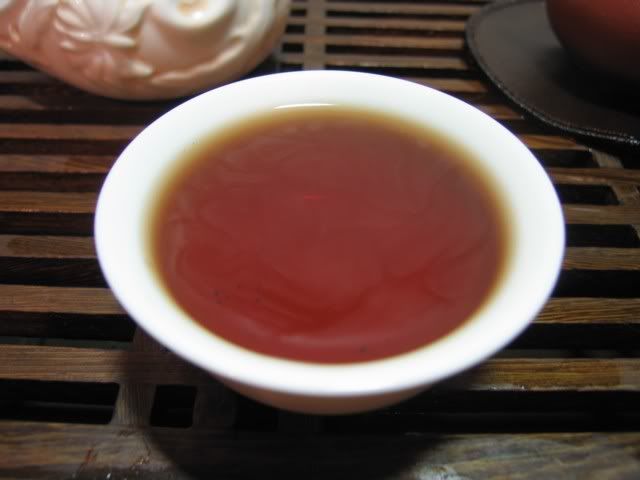Now that we have the 10,000 hits thing out of the way… back to the teas 🙂
Yesterday, along with the scale and the bags of Wuyi tea I got, I was given a small sample of an aged Wuyi tea from the store. Since it’s a small bag, I figured I’ll brew it.
Since I got my new electric scale, I figured I’ll see how much tea they gave me.
It turns out it was 10g, almost to the dot. 10g of tea… that sounds like a lot.
So I warmed my pot, and started putting leaves in it. When I filled it to about what I normally would use… I realized that about 3/4 of the tea I got from the sample is already in the pot. What do I do with the rest? Keep it? It’s too little to do anything with it. Throw it? It’s a waste… so…. I “turned my heart sideways” (a rough translation of a Chinese phrase meaning “to do something with determination”) and threw the rest of the dry tea in there. It just fit in the pot, with a bit of space to spare… 10g of tea in this pot, and the pot is almost filled to the brim with dry leaves.
Yes, yes, tea addict.
In my excitement I forgot to take pictures of the dry leaves. I can say they are rather small and broken, and quite dark — black. It’s broken because it’s obviously been roasted fairly heavily (for storage) and perhaps re-roasted after some years of storage. Anyway, as I remaked yesterday, Wuyi teas are hard to tell apart when dry anyway.
The first infusion brewed a very promising looking liquor — doesn’t this look like aged puerh? This is what happens when you put 90% dry leaves in a pot….

The taste… overwhelmingly the first few infusions has a taste of chenpi (dried mandarin peel). This is what they would call the “chen” taste in tea, usually applying to oolong, as the “chen” taste in puerh is different. The first infusion came out a bit sour. It wasn’t terribly unpleasant in its sourness, but a little sour. Of course, with that much leaves in a small pot…. it’s hard to control. I then decided faster infusions will help, and indeed, the sourness subsided in the second infusion onwards, giving way to more of the “chen” taste. There’s a nice, soft, supple feel to the tea that is usually more obvious in aged Wuyi teas (or aged teas in general). Younger teas tend to be harsher, no matter what you do. Poorly stored aged teas, of course, can also turn bad on you.
Then after about 4-5 infusions, the chen taste subsided, giving way to a lot of sweetness. The brew also got considerably lighter. I increased the infusion time, but the chen taste didn’t come back. Instead, the sweetness persisted. I drank about 10-12 infusions of this. Needless to say, I was pretty worked up by the tea, despite its age and the fact that it’s a roasted Wuyi. It’s a comfortable feeling, not the nervous energy that you get from a young, qingxiang tieguanyin.
I might get more of this…. but I really, really have too much tea already. Then again, it’s hard to come by decent aged oolongs that are not sour or bland. This tea is neither. I should at least go back to the store and try it with less leaves.
The wet leaves…. don’t reveal much.


 RSS - Posts
RSS - Posts
1 response so far ↓
lackerlust // December 10, 2006 at 4:41 pm |
Very interesting.